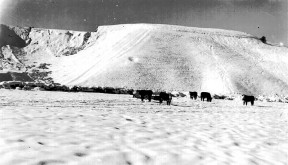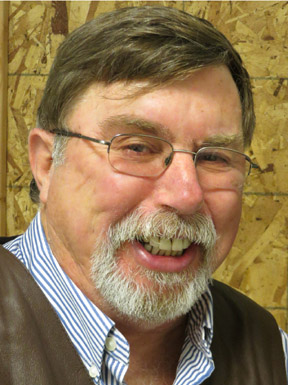As I write this, the outside temperature is in the mid-30s. Cold! So cold, it reminded me of one cold morning in Mentryville around 1965.
As usual, we got up before the sun and started chores. I was milking and taking the milk to the back porch of the house. I poured it into one of the big milk cans and went down to complete the milking.
Next it was time to turn the cows out to graze, and to feed the hogs and chickens. I also had to do one of my least favorite chores: collecting the eggs.
Those chores were complete, so it was back into the house to stand in front or the fire in the dining room until breakfast was ready.
That day I wasn’t getting breakfast on time. It seems the water had stopped flowing out of the kitchen faucet. We had bottled water to make coffee and for other cooking needs, but the other water was not there in the pipes.
It was a Saturday and the sun was rising over the hills to the east. This time of year, the bottom of Pico Canyon doesn’t see full sun until mid-day. Since my father was working, my mother told me to go up the canyon and see if there was a problem at the pump near the schoolhouse, or whether the upper tank had water. That tank was on top of PCO Hill south of CSO No. 4, the old, historic well.
My favorite horse, Suzy, was in the corral, so I went to the barn and got her ready to ride. I should have been thinking I had to break the ice on the water trough in the corral that morning so she could drink. Getting her bridle and saddle on was quickly done, and I rode up the canyon to the lower tank and pump. (The tank is still there.)

It’s not Pico Canyon in the 1960s but it’s close. It’s Potrero Canyon (just over the hill from Pico) in 1949. Click to enlarge & find more info.
The tank was nearly full, and the pump was ready to start. There weren’t any obvious leaks or ponds of standing water nearby. I went up the canyon a little more.
Suzy wasn’t so happy about being out in the cold. She would have been happy back at the corral in the small pole barn my father and I had built.
That barn is still there. Recently restored. Someone called it “historic.” Am I that old?
Anyway, it was cold. The road curves to the left and then back right, and I stopped to break the ice in the water trough at that curve. Had to keep the cattle and deer happy. Back in the saddle, I rode on up to Minnie-Lotta Canyon maybe another 200 yards.
Now there is a footbridge crossing Pico Creek at that canyon. Back then there was nothing but the creek. I could see the foundation for the old bakery, and in the early light it seemed to glisten. Why was that?
The whole flat area at the bakery was covered in ice – thick and starting to sparkle in the early sun rays that found their way between the canyon walls. There were foot-long icicles hanging from trees and a very thick, uneven, frozen waterfall covering the flat area that flowed into the creek.
The creek bottom was also encased in thick ice that had formed up to the road. The formation had stopped when the water stopped spraying. The upper tank must have been emptied when I looked at all the ice that was there. In some places the ice was more than a foot thick.
I now knew why we didn’t have water at Pico Cottage. The water in the pipe had become ice, and burst the pipe. Enough water was able to get around the ice plug in the pipe and start spraying the bakery flat. It must have sprayed for hours.
Riding back to the house, I told my mother the problem and she called the Standard Oil office to get the pipe repaired. In about 30 minutes, men from the company came and started repairs. First they had to chip ice to get to the break.
In the 1962 snow, we never lost water due to frozen pipes. In 1965 the pipes froze. From the tank on top of PCO Hill to the break was a drop of a few hundred feet. There was a lot of pressure in the pipe. Once the pipe burst, the water found a path and all of that force made the hole bigger by expanding the rip in the pipe. That huge tank that was 32 feet in diameter and 16 feet tall emptied through that rip. It was a lot of ice from a lot of water.
In no time at all, the pipe was repaired and water was being pumped up the hill. Pico Cottage had water again. My mother made breakfast for the crew that fixed the pipe. Fresh eggs, our own bacon, hash browns and toast from homemade bread. The butter had been churned that morning, and my mother’s jelly or jam was also on the table.
The ice melted. The pipe is still there. You can see it as you hike up Pico Canyon. It is the larger-diameter pipe. The smaller pipe was for oil. And to think this happened in the 1960s. We had just gotten electricity full-time.
I took Suzy to the barn and made sure she had an extra helping of oats. It had been a short ride, but she deserved the extra. It was so cold that we had ice floes in Pico Canyon. Can’t see that every day.
Keep warm and Happy New Year. See y’all in 2013.
Darryl Manzer grew up in the Pico Canyon oil town of Mentryville in the 1960s and attended Hart High School. After a career in the U.S. Navy he returned to live in the Santa Clarita Valley. He can be reached at dmanzer@scvhistory.com and his commentaries, published on Sundays, are archived at DManzer.com. Watch his walking tour of Mentryville [here].
Frozen Pipes, Chilly Horse | Commentary by Darryl Manzer
